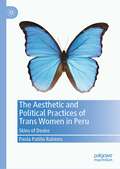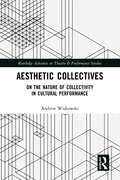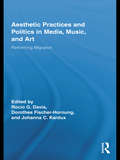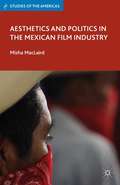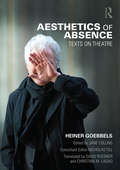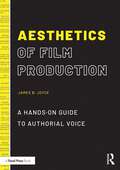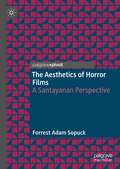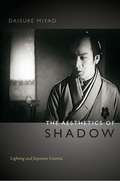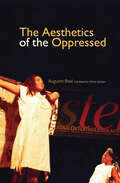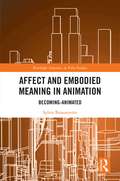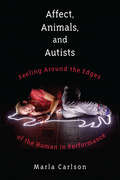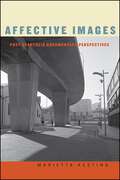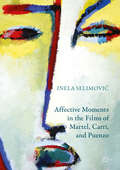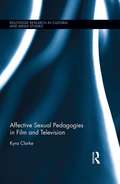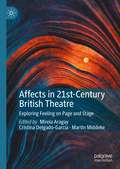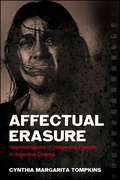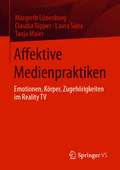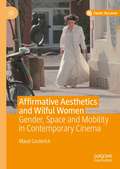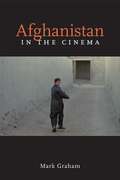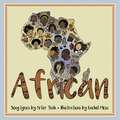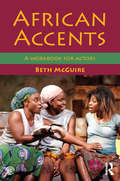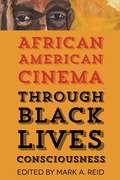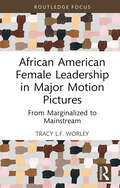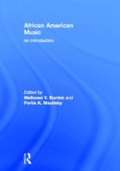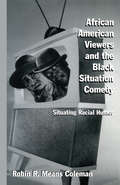- Table View
- List View
The Aesthetic and Political Practices of Trans Women in Peru: Skins of Desire
by Paola Patiño RabinesThis book explores the political-aesthetic practices of transgender women in Lima, Peru, and how they use these to survive and fight for recognition and full citizenship, through drawing on ethnographic research and on decolonial feminist and aesthetic theories. Chapters analyze how the vulnerability and precariousness of trans women coexist with modes of feminist agency, resistance and resilience, as well as with proposals for political action to transform a heteropatriarchal society toward a more diverse and accepting one. Finally, the author draws on the Viennese artist Friedensreich Hundertwasser’s metaphor of the five skins, whereby the first skin is the epidermis; the second is the clothes; the third is the house; the fourth is identity, which refers to primary socialization spaces such as the neighbourhood; and the fifth is the world environment. The author uses this metaphor to analyze the corporal practices of trans women in a cumulative way, paying special attention to the different stages of their lives, to those skins that embody and accompany them from childhood to adulthood.This book will be of interest to scholars of transgender studies, decolonial feminist studies, and aesthetic, particularly those with a focus on gender and sexuality in Latin America.
Aesthetic Collectives: On the Nature of Collectivity in Cultural Performance (Routledge Advances in Theatre & Performance Studies)
by Andrew WiskowskiThis book focuses attention on groups of performing people that are unique aesthetic objects, the focus of an artist’s vision, but at the same time a collective being; a singular, whole mass that exists and behaves like an individual entity. This text explores this unique experience, which is far from rare or special. Indeed, it is pervasive, ubiquitous and has, since the dawn of performance, been with us. Surveying installation art from Vanessa Beecroft & Kanye West, Greek tragedy, back-up dancing groups and even the mass dance of clubbing crowds, this text examines and names this phenomenon: Aesthetic Collectives. Drawing on a range of methods of investigation spanning performance studies, acting theory, studies of atmosphere and affect and sociology it presents an intervention in the literature for something that has long deserved its own attention. This book will be of great interest to scholars, students and practitioners in performance studies, theatre, live art, sociology (particularly of groups and subcultures), cultural studies and cultural geography.
Aesthetic Practices and Politics in Media, Music, and Art: Performing Migration
by Rocío G. DavisThis volume analyzes innovative forms of media and music (art installations, television commercials, photography, films, songs, telenovelas) to examine the performance of migration in contemporary culture. Though migration studies and media studies are ostensibly different fields, this transnational collection of essays addresses how their interconnection has shaped our understanding of the paradigms through which we think about migration, ethnicity, nation, and the transnational. Cultural representations intervene in collective beliefs. Art and media clearly influence the ways the experience of migration is articulated and recalled, intervening in individual perceptions as well as public policy. To understand the connection between migration and diverse media, the authors examine how migration is represented in film, television, music, and art, but also how media shape the ways in which host country and homeland are imagined. Among the topics considered are new mediated forms for representing migration, widening the perspective on the ways these representations may be analyzed; readings of enactments of memory in trans- and inter-disciplinary ways; and discussions of globalization and transnationalism, inviting us to rethink traditional borders in respect to migration, nation states, as well as disciplines.
Aesthetics and Politics in the Mexican Film Industry
by Misha MaclairdAesthetics and Politics in the Mexican Film Industry is the first English-language analysis of what some called a "renaissance" at the turn of the twenty-first century. It examines the years surrounding Mexicos presidential elections in 2000 and the fall of the ruling party after seventy one years in power in order to better understand a moment when politics and cinema shared the limelight. Moving beyond the international blockbusters, the research evaluates a broad selection of films, produced from the early 1990s to the present, to help demystify this period for scholars and students. It explains in clear language how production methods, audience demographics, and aesthetic approaches have changed throughout the past two decades of Mexican cinema and how these changes relate to Mexico's transitions to a democratic political system and free-market economy. "
Aesthetics of Absence: Texts on Theatre
by Heiner GoebbelsAesthetics of Absence presents a significant challenge to the many embedded assumptions and hierarchical structures that have become ‘naturalised’ in western theatre production. This is the first English translation of a new collection of writings and lectures by Heiner Goebbels, the renowned German theatre director, composer and teacher. These writings map Goebbels’ engagement with ‘Aesthetics of Absence’ through his own experience at the forefront of innovative music-theatre and performance making. In this volume, Goebbels reflects on works created over a period of more than 20 years staged throughout the world; introduces some of his key artistic influences, including Robert Wilson and Jean-Luc Godard; discusses the work of his students and ex-students, the collective Rimini Protokoll; and sets out the case for a radical rethinking of theatre and performance education. He gives us a rare insight into the rehearsal process of critically acclaimed works such as Eraritjaritjaka and Stifters Dinge, explaining in meticulous detail the way he weaves an eclectic range of references from fine art, theatre, literature, politics, anthropology, contemporary and classical music, jazz and folk, into his multi-textured music-theatre compositions. As an artist who is prepared to share his research and demystify the processes through which his own works come into being, as a teacher with a coherent pedagogical strategy for educating the next generation of theatre-makers, in this volume, Goebbels brings together practice, research and scholarship.
Aesthetics of Film Production: A Hands-On Guide to Authorial Voice
by James B. JoyceExploring aesthetic decision-making skills through active, critical interpretation of the screenplay, this book investigates the ways filmmakers translate a screenplay into a powerful film. Guiding the reader through the formal choices a filmmaker makes, this book encompasses all aspects of the filmmaking process, including directing, acting, cinematography, lighting, production design, sound, and editing. Author Joyce illustrates how to apply aesthetics in a way that encourages creative thinking and stylistic choices, while emphasizing the importance of active decision-making to foreground the screenplay in the filmmaking process. Focusing on how films should be crafted stylistically from beat to beat, the book provides tangible footholds to assist filmmakers with the aesthetic decision-making process, empowering filmmakers to create films to resonate emotionally and intellectually. Ideal for students of filmmaking and aspiring filmmakers looking to train their gut and hone their creative and aesthetic decision-making in the filmmaking process. Additional online screenplay samples show how one singular story can be told with different emphasis and narrative perspectives.
The Aesthetics of Horror Films: A Santayanan Perspective
by Forrest Adam SopuckThis book analyzes the nature and functions of horror films from the vantage of a theoretical reconstruction of George Santayana’s account of beauty. This neo-Santayanan framework forms the conceptual backdrop for a new model of horror’s aesthetic enjoyment, the nature of which is detailed through the examination of plot, cinematic, and visual devices distinctive of the popular genre. According to this model, the audience derives pleasure from the films through confronting the aversive scenarios they communicate and rationalizing a denial of their personal applicability. The films then come to embody these acts of self-assertion and intellectual overcoming and become objects of pride. How horror films can acquire necropolitical functions within the context of abusive systems of power is also clarified. These functions, which exploit the power of anti-tragedy, downward social comparison, or vicarious emotion, work to remediate aggressive, ascetic, or revolutionary impulses in ways that are not injurious to the status quo. This book champions horror as a source of self-empowerment and unmitigated beauty, but also attests to the potential social harms of the genre.
The Aesthetics of Shadow: Lighting and Japanese Cinema
by Daisuke MiyaoIn this revealing study, Daisuke Miyao explores "the aesthetics of shadow" in Japanese cinema in the first half of the twentieth century. This term, coined by the production designer Yoshino Nobutaka, refers to the perception that shadows add depth and mystery. Miyao analyzes how this notion became naturalized as the representation of beauty in Japanese films, situating Japanese cinema within transnational film history. He examines the significant roles lighting played in distinguishing the styles of Japanese film from American and European film and the ways that lighting facilitated the formulation of a coherent new Japanese cultural tradition. Miyao discusses the influences of Hollywood and German cinema alongside Japanese Kabuki theater lighting traditions and the emergence of neon commercial lighting during this period. He argues that lighting technology in cinema had been structured by the conflicts of modernity in Japan, including capitalist transitions in the film industry, the articulation of Japanese cultural and national identity, and increased subjectivity for individuals. By focusing on the understudied element of film lighting and treating cinematographers and lighting designers as essential collaborators in moviemaking, Miyao offers a rereading of Japanese film history.
The Aesthetics of the Oppressed
by Augusto BoalAugusto Boal's workshops and theatre exercises are renowned throughout the world for their life-changing effects. At last this major director, practitioner, and author of many books on community theatre speaks out about the subjects most important to him – the practical work he does with diverse communities, the effects of globalization, and the creative possibilities for all of us.
Affect and Embodied Meaning in Animation: Becoming-Animated (Routledge Advances in Film Studies)
by Sylvie BissonnetteThis book combines insights from the humanities and modern neuroscience to explore the contribution of affect and embodiment on meaning-making in case studies from animation, video games, and virtual worlds. As we interact more and more with animated characters and avatars in everyday media consumption, it has become vital to investigate the ways that animated environments influence our perception of the liberal humanist subject. This book is the first to apply recent research on the application of the embodied mind thesis to our understanding of embodied engagement with nonhumans and cyborgs in animated media, analyzing works by Émile Cohl, Hayao Miyazaki, Tim Burton, Norman McLaren, the Quay Brothers, Pixar, and many others. Drawing on the breakthroughs of modern brain science to argue that animated media broadens the viewer’s perceptual reach, this title offers a welcome contribution to the growing literature at the intersection of cognitive studies and film studies, with a perspective on animation that is new and original. ‘Affect and Embodied Meaning in Animation’ will be essential reading for researchers of Animation Studies, Film and Media Theory, Posthumanism, Video Games, and Digital Culture, and will provide a key insight into animation for both undergraduate and graduate students. Because of the increasing importance of visual effect cinema and video games, the book will also be of keen interest within Film Studies and Media Studies, as well as to general readers interested in scholarship in animated media.
Affect, Animals, and Autists: Feeling Around the Edges of the Human in Performance
by Marla CarlsonWhen theater and related forms of live performance explore the borderlands labeled animal and autism, they both reflect and affect their audiences’ understanding of what it means to be human. Affect, Animals, and Autists maps connections across performances that question the borders of the human whose neurodiverse experiences have been shaped by the diagnostic label of autism, and animal-human performance relationships that dispute and blur anthropocentric edges. By analyzing specific structures of affect with the vocabulary of emotions, Marla Carlson builds upon the conception of affect articulated by psychologist Silvan Tomkins. The book treats a diverse selection of live performance and archival video and analyzes the ways in which they affect their audiences. The range of performances includes commercially successful productions such as The Curious Incident of the Dog in the Night-Time, War Horse, and The Lion King as well as to the more avant-garde and experimental theater created by Robert Wilson and Christopher Knowles, Back to Back Theatre, Elevator Repair Service, Pig Iron Theatre, and performance artist Deke Weaver.
Affective Images: Post-apartheid Documentary Perspectives (SUNY Press Open Access)
by Marietta KestingAffective Images examines both canonical and lesser-known photographs and films that address the struggle against apartheid and the new struggles that came into being in post-apartheid times. Marietta Kesting argues for a way of embodied seeing and complements this with feminist and queer film studies, history of photography, media theory, and cultural studies. Featuring in-depth discussions of photographs, films, and other visual documents, Kesting then situates them in broader historical contexts, such as cultural history and the history of black subjectivity and revolves the images around the intersection of race and gender. In its interdisciplinary approach, this book explores the recurrence of affective images of the past in a different way, including flashbacks, trauma, "white noise," and the return of the repressed. It draws its materials from photographers, filmmakers, and artists such as Ernest Cole, Simphiwe Nkwali, Terry Kurgan, Thenjiwe Niki Nkosi, Adze Ugah, and the Center for Historical Reenactments.This book is freely available in an open access edition thanks to Knowledge Unlatched—an initiative that provides libraries and institutions with a centralized platform to support OA collections and from leading publishing houses and OA initiatives. Learn more at the Knowledge Unlatched website at: https://www.knowledgeunlatched.org/, and access the book online at the SUNY Open Access Repository at <a href="http://hdl.handle.net/20.500.12648/7134 ">http://hdl.handle.net/20.500.12648/7134 .
Affective Moments in the Films of Martel, Carri, and Puenzo
by Inela Selimović<P>This book studies the intimate tensions between affect and emotions as terrains of sociopolitical significance in the cinema of Lucrecia Martel, Albertina Carri, and Lucía Puenzo. Such tensions, Selimović argues, result in “affective moments” that relate to the films’ core arguments. <P>They also signal these filmmakers’ novel insights on complex manifestations of memory, desire, and violence. <P>The chapters explore how the presence of pronounced—but reticent—affect complicates emotional bonding in the everydayness depicted in these films. By bringing out moments of affect in these filmmakers’ diegetic worlds, this book traces the ways in which subtle foci on gender, class, race, and sexuality correlate in these Argentine women’s films.
Affective Sexual Pedagogies in Film and Television (Routledge Research in Cultural and Media Studies)
by Kyra ClarkePopular film and television hold valuable potential for learning about sex and sexuality beyond the information-based model of sex education currently in schools. This book argues that the representation of complicated—or "messy"—relationships in these popular cultural forms makes them potent as affective pedagogical moments. It endeavours to develop new sexual literacies by contemplating how pedagogical moments, that is, fleeting moments which disrupt expectations or create discomfort, might enrich the available discourses of sexuality and gender, especially those available to adolescents. In Part One, Clarke critiques the heteronormative discourses of sex education that produce youth in particularly gendered ways, noting that "rationality" is often expected to govern experiences that are embodied and arguably inherently incoherent. Part Two explores public intimacy, contemplating the often overlapping and confused boundaries between public and private.
Affects in 21st-Century British Theatre: Exploring Feeling on Page and Stage
by Mireia Aragay Cristina Delgado-García Martin MiddekeThis book explores the various manifestations of affects in British theatre of the 21st century. The introduction gives a concise survey of existing and emerging theoretical and research trends and argues in favour of a capacious understanding of affects that mediates between more autonomous and more social approaches. The twelve chapters in the collection investigate major works in Britain by playwrights and theatre makers including Mojisola Adebayo, Mike Bartlett, Alice Birch, Caryl Churchill, Tim Crouch and Andy Smith, Rachel De-lahay, Reginald Edmund, James Fritz, David Greig, Idris Goodwin, Zinnie Harris, Kieran Hurley, Lucy Kirkwood, Anders Lustgarten, Yolanda Mercy, Anthony Neilson, Lucy Prebble, Sh!t Theatre, Penelope Skinner, Stef Smith, Kae Tempest and debbie tucker green. The interpretations identify significant areas of tension as they relate affects to the fields of cognition, politics and hope. In this, the chapters uncover interrelations of thought, intention and empathy; they reveal the nexus between identities, institutions and ideology; and, finally, they explore how theatre can accomplish the transition from a sense of crisis to utopian visions.
Affectual Erasure: Representations of Indigenous Peoples in Argentine Cinema (SUNY series in Latin American Cinema)
by Cynthia Margarita TompkinsAffectual Erasure examines how Argentine cinema has represented Indigenous peoples throughout a period spanning roughly a century. Cynthia Margarita Tompkins interrelates her discussion of films with the ethnographic context of the Indigenous peoples represented and an analysis of the affective dimensions at play. These emotions underscore the inherent violence of generic conventions, as well as the continued political violence preventing Indigenous peoples from access to their ancestral lands and cultural mores. Tompkins explores a broad range of movies beginning in the silent period and includes both feature films and documentaries, underscored by archival and contemporary film stills. She traces the initial erotic projection, moving through melodrama to the conventions of the Western, into the 1960s focus on decolonization, superseded by allegorical renditions and the promise of self-expression in late twentieth-century documentaries. Each section includes an introduction to the sociohistorical events of the period and their impact on film production. Analyzed chronologically, the films evidence different stages in the projection of the hegemonic Argentine imaginary, which fails to envision the daily life of Indigenous peoples prior to conquest or in colonial times—and remains in denial of their existence in the present.
Affektive Medienpraktiken: Emotionen, Körper, Zugehörigkeiten im Reality TV
by Margreth Lünenborg Claudia Töpper Laura Sūna Tanja MaierDas Buch liefert eine affekttheoretisch informierte Analyse des Reality TV. Dabei wird das komplexe Affektgeschehen zwischen Fernsehsendung, Medientechnologie und den Körpern der Zuschauenden empirisch zugänglich und sichtbar. Eine multiperspektivische Analyse zeigt auf, welche Strategien und Muster der Erzeugung von Affekten und Emotionen Fernsehproduzent*innen nutzen, wie Inklusion und Exklusion im audiovisuellen Medientext für Zuschauende körperlich spürbar wird und welche Spuren Affekte in den Körpern und den Diskursen des Publikums hinterlassen. Auf den Ebenen Körper, Diskurse und Praktiken werden auf diese Weise affektive Dynamiken der Aushandlung von Zugehörigkeiten analysiert. Die Studie leistet damit einen methodisch wie auch theoretisch innovativen Beitrag zur Affekt- und Emotionsforschung in der Kommunikationswissenschaft.
Affirmative Aesthetics and Wilful Women: Gender, Space and Mobility in Contemporary Cinema
by Maud CeuterickFifty years of feminist thought have made the idea that women stay at home while men dominate the streets seem outdated; nevertheless, Ceuterick argues that theoretical considerations of gender, space, and power in film theory remain limited by binary models. Looking instead to more fluid models of spatial relations inspired by Sara Ahmed, Rosi Braidotti, and Doreen Massey, this book discovers wilful, affirmative, and imaginative activations of gender on screen. Through close, micro-analysis of historic European Messidor (Alain Tanner, 1979) and contemporary world cinema: Vendredi Soir (Claire Denis, 2002), Wadjda (Haifaa Al-Mansour, 2012), and Head-On (Fatih Akin, 2004), this book identifies affirmative aesthetics: light, texture, rhythm, movement and sound, all of which that participate in a rewriting of bodies and spaces. Ultimately, Ceuterick argues, affirmative aesthetics can challenge the gender categories and power structures that have been thought to determine our habitation of cars, homes, and city streets. Wilful women drive this book forward, through their movement and stillness, imagination and desire, performance and abjection.
Afghanistan in the Cinema
by Mark GrahamIn this timely critical introduction to the representation of Afghanistan in film, Mark Graham examines the often surprising combination of propaganda and poetry in films made in Hollywood and the East. Through the lenses of postcolonial theory and historical reassessment, Graham analyzes what these films say about Afghanistan, Islam, and the West and argues that they are integral tools for forming discourse on Afghanistan, a means for understanding and avoiding past mistakes, and symbols of the country's shaky but promising future. Thoughtfully addressing many of the misperceptions about Afghanistan perpetuated in the West, Afghanistan in the Cinema incorporates incisive analysis of the market factors, funding sources, and political agendas that have shaped the films. The book considers a range of films, beginning with the 1970s epics The Man Who Would Become King and The Horsemen and following the shifts in representation of the Muslim world during the Russian War in films such as The Beast and Rambo III. Graham then moves on to Taliban-era films such as Kandahar, Osama, and Ellipsis, the first Afghan film directed by a woman. Lastly, the book discusses imperialist nostalgia in films such as Charlie Wilson's War and destabilizing visions represented in contemporary works such as The Kite Runner.
African: A Children's Picture Book (LyricPop #0)
by Peter ToshAn AALBC Recommended New Book! Included in Publishers Weekly's Children's Galleys to Grab at Winter Institute! A beautiful children's picture book featuring the lyrics of Peter Tosh's global classic celebrating children of African descent. So don't care where you come from As long as you're a black man, you're an African No mind your nationality You have got the identity of an African African is a children's book featuring lyrics by Peter Tosh and illustrations by Jamaican artist Rachel Moss. The song "African" by Peter Tosh was originally released in 1977 on his second solo record, Equal Rights. He wrote the song during a time of civil unrest in Jamaica as a reminder to all black people that they were part of the same community. The album is considered one of the most influential reggae works of all time. A key song from the classic 1970s era of reggae Peter Tosh was one of the founding members of the iconic reggae group the Wailers
African Accents: A Workbook for Actors
by Beth McGuireThis is a comprehensive workbook for actors, covering the key characteristics and profiles of a wide range of African accents of English. Its unique approach not only addresses the methods and processes by which to go about learning an accent, but also looks in detail at each example. This lets the reader plot their own route through the learning process and tailor not only their working methods but also their own personal idiolect. Full breakdowns of each accent cover: an introduction giving a brief history of the accent, its ethnic background, and its language of origin preparatory warm-up exercises specific to each accent a directory of research materials including documentaries, plays, films and online resources key characteristics such as melody, stress, pace and pitch descriptions of physical articulation in the tongue, lips, jaw, palate and pharynx practice sentences, phoneme tables and worksheets for solo study. African Accents is accompanied by a website at www.routledge.com/cw/mcguire with an extensive online database of audio samples for each accent. The book and audio resources guide actors to develop their own authentic accents, rather than simply to mimic native speakers. This process allows the actor to personalize an accent, and to integrate it into the creation of character rather than to play the accent on top of character.
African American Cinema through Black Lives Consciousness
by Dr Melba Joyce Boyd Dr Jonathan Munby Gerald R. Butters Jr. Charlene Regester African American Cinema James Smalls African American Cinema Anne Cremieux African American Cinema Chesya Burke African American Cinema Kimberly Nichele Brown African American Cinema Patricia Hilliard-Nunn African American Cinema Mark D Cunningham African American Cinema Dan Flory Karen Bowdre Mark A. ReidAfrican American Cinema through Black Lives Consciousness uses critical race theory to discuss American films that embrace contemporary issues of race, sexuality, class, and gender. Its linear history chronicles black-oriented narrative film from post–World War II through the presidential administration of Barack Obama. Editor Mark A. Reid has assembled a stellar list of contributors who approach their film analyses as an intersectional practice that combines queer theory, feminism/womanism, and class analytical strategies alongside conventional film history and theory. Taken together, the essays invigorate a "Black Lives Consciousness," which speaks to the value of black bodies that might be traumatized and those bodies that are coming into being-ness through intersectional theoretical analysis and everyday activism. The volume includes essays such as Gerald R. Butters’s, "Blaxploitation Film," which charts the genre and its uses of violence, sex, and misogyny to provoke a realization of other philosophical and sociopolitical themes that concern intersectional praxis. Dan Flory’s "African-American Film Noir" explains the intertextual—fictional and socio-ecological—dynamics of black action films. Melba J. Boyd’s essay, "‘Who’s that Nigga on that Nag?’: Django Unchained and the Return of the Blaxploitation Hero," argues that the film provides cultural and historical insight, "signifies" on blackface stereotypes, and chastises Hollywood cinema’s misrepresentation of slavery. African American Cinema through Black Lives Consciousness embraces varied social experiences within a cinematic Black Lives Consciousness intersectionality. The interdisciplinary quality of the anthology makes it approachable to students and scholars of fields ranging from film to culture to African American studies alike.
African American Female Leadership in Major Motion Pictures: From Marginalized to Mainstream (Routledge Studies in Media Theory and Practice)
by Tracy L.F. WorleyThis book explores the factors contributing to the under-representation of African American female directors in mainstream cinema leadership. It also unmasks the potential strategies African American female film directors might pursue to reduce this inequity.Author Tracy L. F. Worley draws on research around ethics to conclude that there are specific consequences of the male gaze on women in cinema leadership, especially African American female directors of box office cinema. Combining extensive analysis of ethics and ethical stance relative to the motion picture industry with perspectives from working African American female directors, the text discusses the ethical considerations and historical inequities, including the male gaze, and uses those findings to define how the inequities can be opportunities. The efficacy model for cinematic leadership is presented as a mechanism for viewing obstacles through the lenses of gender, ethnicity, and culture so they become drivers for African American women to achieve success.Ideal for students of directing and filmmaking, as well as aspiring professional filmmakers wishing to gain a better understanding of the industry as it stands today.
African American Music: An Introduction
by Mellonee Burnim Portia K. MaultsbyAfrican American Music: An Introduction is a collection of thirty essays by leading scholars which survey major African American musical genres, both sacred and secular, from slavery to the present. It is the most comprehensive study of African American music currently available, with sixteen essays on major genres of African American music, as well as lengthy sections on the music industry, gender, and music as resistance. The work brings together, in a single volume, treatments of African American music that have existed largely independent of each other. The research is based in large part on ethnographic fieldwork, which privileges the voices of the music-makers themselves, while interpreting their narratives through a richly textured mosaic of history and culture. The book is replete with references to seminal recordings and recording artists, musical transcriptions, photographs, and illustrations that bring the music to life as expressions of human beings.
African American Viewers and the Black Situation Comedy: Situating Racial Humor (Studies in African American History and Culture)
by Robin R. Means ColemanProviding new insight into key debates over race and representation in the media, this ethnographic study explores the ways in which African Americans have been depicted in Black situation comedies-from 1950's Beulah to contemporary series like Martin and Living Single.
